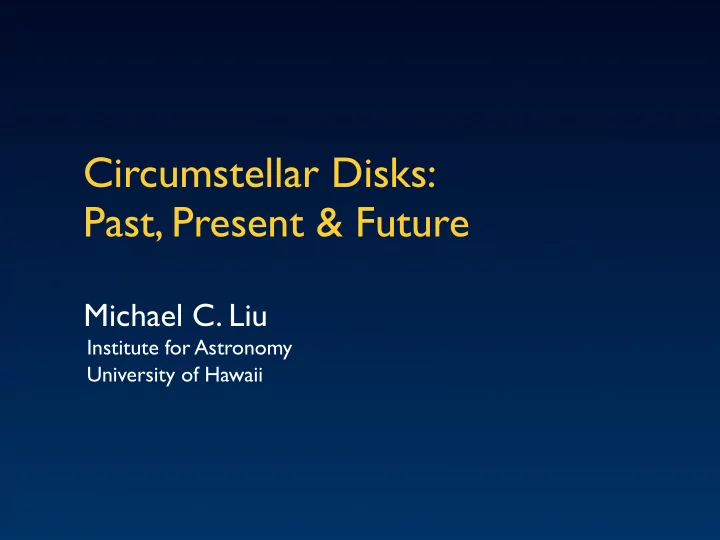

Circumstellar Disks: Past, Present & Future Michael C. Liu Institute for Astronomy University of Hawaii
Overview of disk evolution Observability
Extrasolar planets Mass function Orbital properties eccentricity semi-major axis
Primordial Disks
Obligatory star formation slide
Disk anatomy: Multi-wavelength Hartmann 1998
Spectral energy distributions • Primary observation for studying physical properties of circumstellar material (dust). • 1968: NIR excesses around T Tauri stars. • 1974: viscous accretion disks. • 1983: IRAS (12-100 um) • c.1988: IR SEDs represent an evolutionary sequence, tracing the relative contributions of envelope, disk + star. • Detailed modeling continues today. Lada + Shu 1990
Disk structure: IR emission Two-layer model 1. Heated dust surface 2. Cooler interior Chiang & Goldreich (1997)
Disk structure: IR emission depends on mixing of dust + gas (dust settling) grain minerology (composition, sizes) Chiang et al (2001)
O’Dell et al (1996)
Padgett et al (1999)
Disk imaging: Scattered optical light Burrows et al (1996)
Imaging of gas (CO) disks: Keplerian rotation Simon et al (2000)
IR Diagnostics of Protoplanetary Disks J. Najita
J. Najita
Disk masses: millimeter fluxes Natta (2003) Minimum mass solar nebula What produces the Text dispersion in disk properties ? M(disk) ~ 0.03 M(star) How do disk properties change over the mass spectrum?
Disks around Brown Dwarfs
Disks around young brown dwarfs Liu et al 2003 IR excess vs SpT disks disk disk (~75 Mjup) (~50 Mjup) no disk no disk (~30 Mjup) (~15 Mjup) disk disk no disk no disk IR Excesses
Young BDs: sub-mm emission Pascucci et al 2003
Non “star-like” formation of brown dwarfs ? Watkins et al 1998 (2000 AU x 1500 AU) Reipurth 2000
Disk frequency Haisch et al 2001 Muzerolle et al 2003 Liu et al 2003
Disk accretion rates Muzerolle et al 2003
Transition disks
Disk evolution Clarke et al (2001) • What governs the character & timescale(s) log(surface density) for disk evolution ? • Inner disk: Viscous ( ?? ) accretion • Outer disk: Photoevaporation • Grain growth ? log (r/AU)
Disks in transition (~5- 1 0 Myr) • Timescale for disappearance of inner HR 4796: ~10 Myr (near-IR) disks ~5-10 Myr. • Possible diagnostics of disk “aging”: • Change in geometry (imaging) • Evolution of SED • Decrease in accretion rates • Grain growth & evolution • Decrease in dust + gas mass • • Hard to find young stars at these ages. Schneider et al 1999
Disks in transition: TW Hya (~10 Myr) Calvet et al (2002) Text • far-IR: outer disk of gas + dust • mid-IR: edge of outer disk (”wall”) • 1 0 um peak: inner disk of small grains • mm flux: large (> 1 cm) grain growth Grain growth + evacuated inner disk = planet ?
Debris disks
Debris disks (>~ 1 0 Myr) • IRAS : ~15% of MS stars Vega (~300 Myr) have far-IR excesses. 60 um • Cold dust at >10’s AU. 100 um • Dust lifetime is short (PR drag, radiation pressure, collisions) compared to age of star. 25 um • Dust from collisions of 12 um unseen larger bodies. Aumann et al (1984) • M(dust) ~ few M(moon) • Gas-poor.
Debris disk evolution Spangler et al (2001)
Dusty circumstellar disks (and planets) epsilon Eridani: 700 Myr (sub-mm) Fomalhaut: 200 Myr (sub-mm) Greaves et al 1998 Holland et al 2003
Vega’s debris disk: mm interferometry Wilner et al (2002) 3 Mjup, a~40 AU, ecc~0.6
Dusty circumstellar disks (and planets) • Known debris disk samples are incomplete (e.g. biased to more luminous stars). • New disk around a young (~100 Myr), nearby (30 pc) Sun-like star R in ~30 AU (sub-mm) Williams, Najita, Liu et al 2003, submitted
The Disk-Planet Connection
Searching for young exoplanets
Searching for young exoplanets • Young ( 1-1 00 Myr) massive planets 1” have significant thermal emission. • Direct detection becomes tractable with adaptive optics on 8- 1 0 m telescopes (Keck, Gemini, Subaru, VLT). • Flux ratios of > 1 0 mag at < 1 -2”. • Measure colors, Teff, Lbol, atms. Keck AO: H-band (1.6 µ m)
Future Capabilities
SIRTF (Space IR Telescope Facility) Meyer et al (2002)
SIRTF (Evans et al): Disk spectral evolution Few My 10 My 100 My 5 Gy
AO in the (near) future: Laser guide star Keck Observatory HL Tau (2.1 um) Keck LGS AO: Sept 2003
XAOPI: eXtreme Adaptive Optics Planet Imager u LLNL, UC Berkeley, UCSC, UCLA, Caltech, JPL 1.6 arcseconds PI: Bruce Macintosh (LLNL) u ~3000 actuator AO system for Keck 10-m u Science goals Direct detection of extrasolar planets. n Characterization of circumstellar dust. n u Status: 2002-2003 Conceptual design study System could be deployed in 2007. n u System is intended to be facility-class Simulated 15 minute XAOPI Wide variety of high-contrast science programs. n H-band image showing an 8 Jupiter- mass planet near a solar-type star Targets brighter than mR~7-10. n
The time domain: KH 15D Herbst et al (2002)
The time domain: KH 15D Bryden et al (1999) Herbst et al (2002)
The time domain: Pan-STARRS • Dedicated wide-field optical survey system. • Four 2-m telescopes. • FOV = 7 sq.deg, 1 billion pixel OTCCD. • Multi-color, multi-epoch record of the (northern) sky. • Operational 2007. IfA/Hawaii, MHPCC, SAIC, Lincoln Lab PI: Nick Kaiser
• Physical & temporal evolution of dust + gas. • Origin & consequences of the diversity of disks. • Properties of disks across the mass spectrum. • • Concrete connections between disks and planets.
Recommend
More recommend